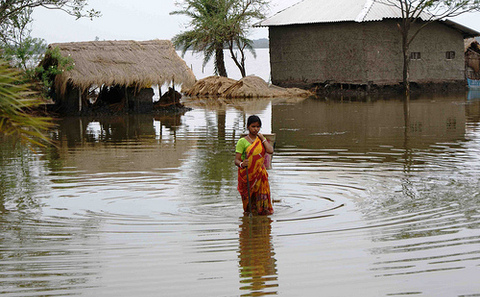The Third Pole editor Beth Walker reports on a promising new water project from Stockholm Water Week – but will China come onboard?

China and its Asian neighbours have long considered data about water flow in shared rivers a national secret, and diplomatic efforts to improve openness have reached an impasse.
Attending the World Water Week in Stockholm this week, where experts gathered from across the world to discuss the theme of “water cooperation”, I came across one promising project building trust between countries in the Himalayas.
At the side lines of the event, I spoke with Bangladeshi hydrologist Shahriar Wahid about a new network of flood warning stations in the Himalayas – where Asia’s major rivers flow from China downstream to South Asia – that may serve to break this impasse.
The waters of the Himalayan rivers has become the focus of a regional racefor water resources as countries seek to secure dwindling water supplies and hydropower to fuel their economies. Governments are tripping over themselves to stake their rights to rivers by building dams before their neighbours, in one of the most earthquake and flood prone regions of the world. India, Pakistan, Nepal and Bhutan have plans for more than 400 hydro dams. In addition, China has plans for around 100 dams to generate a similar amount of power from major rivers rising in Tibet.
So far deep seated political mistrust between counties has prevented any discussion about the cumulative impacts of poorly planned projects on river ecosystems and the 1.5 billion people who live in the Himalayan watershed. This means engineers and planners are essentially building in the dark.
Speaking at a parallel high level panel at “World Water Week”, China’s vice minister of water Hu Siyi stated that China “values international cooperation” on water – as essential for tackling the country’s own domestic water crisis. But the international community must respect individual country’s right to develop water resources as they see fit, Hu warned.
This will do little to assuage downstream countries in South Asia who worry that China’s water struggles will overspill its borders and reduce their own water supply.
Wahid has been working with the International Centre for Integrated Mountain Development (ICIMOD) – a regional agency of which China and India both belong – to install flood forecasting stations across the Himalayas, with the support of national governments.
Floods wreak havoc in the monsoon season across the Himalayas every year. In June, the region was devastated by its worst floods in 50 years. Surging monsoon floodwater killed at least 5,700 people and burst dams in northern India and Nepal.
ICIMOD has provided governments with computers and technical support on the condition that river flow data collected is made publically available for anybody to use. In fact, the data is sent straight from the stations to the web– so it is available in real time.
In a region where national laws prohibit officials revealing any data about water quantity on international rivers, this is a big step.
Progress has moved slowly over the past five years, Wahid admitted, but the data collected so far has allowed ICIMOD to develop a pilot regional flood forecasting model. This means countries will have vital information on river flow above and below their borders, and will give communities living along rivers more time to react when floods strike.
So far stations have been installed in Nepal, Pakistan, Bangladesh and Bhutan. India and China are not sharing data yet – but they are playing an active role as part of the project’s steering committee. Wahid is optimistic that in due course they will join; “We’re encouraging countries to sit around the table and see what data needs to be collected. The idea is to encourage parties to see the benefits.”
There are signs that India is coming around. After the brutal floods in Uttarakhand this summer, Indian officials approached ICIMOD for fresh discussion about data sharing. This still leaves China.
“It’s a small step”, Wahid admitted, but building mechanisms for regional river cooperation is a thorny task. “Our focus is to start simple, let the local people be involved and let it grow in scale.”
